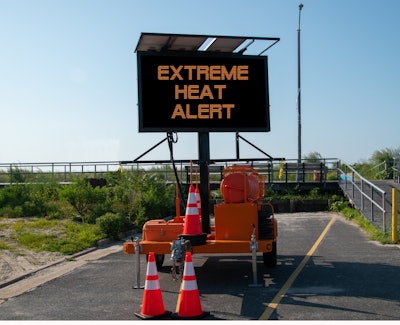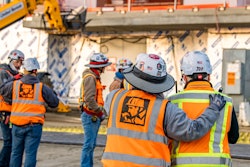
The construction industry faces challenges in keeping workers safe due to the human exposure to the high temperatures that are common during the summer months. While the warm, non-wet weather is great for construction projects production, it also brings risks of extreme heat and humidity, which can create dangerous working conditions. According to the U.S. Bureau of Labor Statistics, in the period of 2021-2022, there were 620 workplace injuries related to extreme heat in the construction industry, highlighting the urgent need for effective safety management strategies. In the article below, we explore why construction workers are especially at risk of heat-related illnesses, provide best practices for reducing these risks, and examine the changing regulations aimed at protecting workers during the hottest months of the year.
Why Construction Workers Are at Risk
The increasing occurrence of record-breaking temperatures nationwide has raised the dangers associated with outdoor labor, particularly for construction workers. There are several reasons why construction workers are especially vulnerable to heat-related illnesses. The physical demands of their work generate a significant amount of body heat. Construction required tasks such as lifting heavy materials, operating machinery, and engaging in prolonged physical exertion, adding to the increase in internal body temperature. This increased heat accumulation makes workers more susceptible to heat-related conditions, including heat exhaustion and, if unaddressed, heat stroke. While protective gear such as hard hats, heavy boots, gloves, and safety suits are essential for overall safety, it can inadvertently trap heat. This trapped heat and reduced sweat evaporation, increase the risk of overheating and heat stress.
Construction work often takes place in environments where shade is scarce or unavailable. As such, construction workers often work in direct sunlight. This direct exposure to the sun not only compounds the heat illness challenge, but prolonged exposure to the sun heightens the risk of sunburn and long-term skin damage, including skin cancer. Without adequate relief from direct sunlight, workers are continuously exposed to elevated temperatures, which increases the likelihood of heat-related health issues.
Mitigating the Risks with Best Practices
Proactive employee-focused prevention is crucial for ensuring safety on construction sites. Implementing best practices can significantly reduce risk and protect workers from the adverse effects of extreme temperatures. Below are several strategies for proactive mitigation:
- Hydration: Providing ample access to water is one of the simplest, yet effective, ways to combat heat stress. Employers should ensure that workers have constant access to cool, drinkable water and encourage frequent hydration breaks. Proper hydration helps the body regulate temperature and reduces the risk of heat exhaustion. Please check your local, regional, and state requirements for hydration per worker.
- Shade and Cooling Stations: Identifying and setting up site wide shaded areas and cooling stations provides workers with much-needed relief from the sun's intensity. Temporary shade structures or tents that can be fitted with cooling fans help lower workers' body temperatures and provides a break from direct sunlight. These shade structures need to be sized to adequately support the number of construction workers on the site each day.
- Adjusting Work Schedules: Scheduling strenuous construction tasks to occur during cooler parts of the day. Revising the work schedule to early mornings or late afternoons, minimizes exposure of the crews to the day’s peak heat of the afternoons. Employers should consider adjusting work hours, or implementing a modified work schedule, avoiding the hottest periods of the day. Work closely with site managers to understand the restrictions of the site EIR, for allowable work hours, as well as understanding if there is a change in work hours and any overtime requirements for alternate work hours.
- Training and Education: Comprehensive safety training is essential for preparing workers to recognize and respond to heat-related illnesses. Educating workers about the symptoms of heat stress, heat exhaustion, and heat stroke is a minimum of this site-specific training. Including the importance of hydration and rest, enhances the workers ability to stay safe when extreme temperatures are forecasted for the project site.
- Innovative Technologies: Embracing new technologies can further enhance heat management efforts. For instance, the Kenzen Body Heat Sensor System offers an affordable, high-tech solution for monitoring and managing an individual workers' heat levels. This system uses wearable sensors to track body temperature and provides real-time data to ensure that workers remain within safe temperature ranges. By integrating innovative and proven technology tools, employers are better able to proactively address heat stress and optimize worker safety on both a personal, and sitewide level.
- Creating a Safety Culture:Fostering a site-wide culture of safety within the organization is crucial for effective heat management. A robust safety training program, combined with ongoing support from management, best creates an environment where safety is prioritized. By reinforcing optimal safety practices throughout the company projects, as Contractor is embracing safety as a company cultural imperative. There are measurable outcomes of a Culture of Safety, allowing employers to keep projects on schedule, as well as aligning the company to achieve broader business goals. By reinforcing the importance of a safety-first mindset throughout the industry a company shows its workers that they care for their individual safety and livelihood, which is the groundwork for long term employment and worker loyalty, which is a goal of most companies.
Industry Change and Regulation
Heat stress regulations are evolving, prioritizing worker protection in extreme temperatures. Many states and local authorities have introduced regulations addressing heat risks on construction sites. These regulations include provisions for worker training, access to water and shade, and site planning by Contractors for extreme temperatures. For example, California has the Heat Illness Prevention Standard (T8CCR 3395), which mandates specific measures when temperatures reach 80°F or higher. Additionally, California has introduced the (T8CCR 3396) effective June 20, 2024, which requires employers to provide cool, drinkable water and accessible cooling areas when indoor temperatures exceed 82°F. These state-specific regulations highlight the increasing focus on safeguarding workers from heat-related illnesses. Indoor Heat Standard (T8CCR 3396) effective June 24, 2024, which requires employers to provide cool, drinkable water and accessible cooling areas when indoor temperatures exceed 82°F. These two state-specific regulations highlight the increasing focus on safeguarding workers from heat-related illnesses.
At the federal level, The Department of Labor is working on publishing a rule aimed at reducing heat stress and illness among construction workers nation-wide. The proposed standard includes provisions for mandatory breaks, access to shade and water, and comprehensive training that recognizes and how to best respond to heat-related conditions of construction workers. OSHA is actively seeking feedback from stakeholders and the public as part of the Standard development process. Standards are updated regularly, and both Federal OSHA and your state and local regulators are required to update the community on any changes that do occur. It is essential that the Contractor stays current on the heat illness regulations, best ensuring that their projects present and implement effective heat stress management oversight on each of their projects.
If you are looking to enhance your workplace policies, investigate the required federal regulations, state regulations and industry best practices. Some states that are more arid, like Nevada, California and Arizona can offer more insight into protecting workers during high temperature periods and with enhanced guidelines and regulations.
Be Cool
As summer progresses, it is important to recognize and address heat-induced illnesses. Areas of focus should include heat stress, heat exhaustion, and heat stroke. State and Federal law has been clear to state that “Employers have a fundamental responsibility to provide safe working conditions by implementing measures to mitigate the impact of extreme heat”. Prioritizing safety involves not only adhering to best practices and adopting innovative technologies, but also cultivating a company culture that values worker well-being. Heat illness is a great place to focus your companies talents in relations to safety and worker comfort during the summer months.
By addressing heat-related risks through careful planning, proactive measures, and compliance with evolving regulations, the construction industry can better protect its workforce and maintain productivity during the hot-weather months. Ensuring worker safety in extreme temperatures is not just a regulatory requirement, but a moral imperative. Heat Illness prevention underscores the commitment to safeguarding those who contribute to the industry’s, and your company's, success.



















